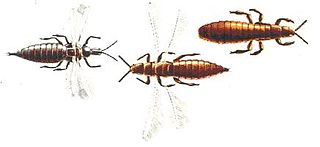
Thrips are minute, slender insects with fringed wings and unique asymmetrical mouthparts. Different thrips species feed mostly on plants by puncturing and sucking up the contents, although a few are predators. Entomologists have described approximately 6,000 species. They fly only weakly and their feathery wings are unsuitable for conventional flight; instead, thrips exploit an unusual mechanism, clap and fling, to create lift using an unsteady circulation pattern with transient vortices near the wings.

Clidemia is a genus of flowering plants in the family Melastomataceae. It contains about 450 species, the best known being C. hirta (soapbush). The generic name honours Ancient Greek author Cleidemus.

Clidemia hirta, commonly called soapbush or Koster's curse, is a perennial shrub. It is an invasive plant species in many tropical regions of the world, creating serious damage.
The Phlaeothripinae are a subfamily of thrips, with hundreds of genera.

Phlaeothripidae is a family of thrips with hundreds of genera. They are the only extant family of the suborder Tubulifera, alongside the extinct family Rohrthripidae and are themselves ordered into two subfamilies, the Idolothripinae with 80 genera, and the Phlaeothripinae with almost 400. Some 3,400 species are recognised in this family, and many are fungivores living in the tropics.
Liothrips is a genus of thrips with almost 300 described species. They are ordered into three subgenera, Epiliothrips, Liothrips and Zopyrothrips.
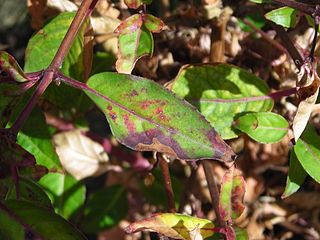
Impatiens necrotic spot orthotospovirus(INSV) is a plant pathogenic virus of the order Bunyavirales. It was originally believed to be another strain of Tomato spotted wilt virus but genetic investigations revealed them to be separate viruses. It is a single stranded RNA It has a tripartite genome and is largely spread by the insect vector of the western flower thrips. The virus infects more than 648 species of plant including important horticultural and agricultural species such as fuchsia, tomato, orchids, and lettuce. As the name implies, the main symptom on plants is necrotic spots that appear on the leaves. The INSV virus infects by injecting the RNA the virus contains into the cell which then starts using the cell resources to transcribe what the virus RNA states. Viral infection can often result in the death of the plant. The disease is mainly controlled by the elimination of the western flower thrip vector and by destroying any infected plant material.
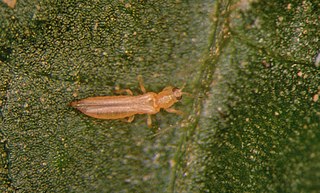
The western flower thrips [Frankliniella occidentalis (Pergande)] is an invasive pest insect in agriculture. This species of thrips is native to the Southwestern United States but has spread to other continents, including Europe, Australia, and South America via transport of infested plant material.
Antiblemma acclinalis is a moth of the family Noctuidae first described by Jacob Hübner in 1823. It is native to the Antilles. It was introduced in Hawaii to control Clidemia hirta. Although it has become established on Oahu, there is no indication that populations have persisted on Kauai or on Maui, where the moth was first released in 1996.
Ategumia matutinalis is a moth of the family Crambidae described by Achille Guenée in 1854. It is found in Central America, South America and the Antilles, including Puerto Rico, Trinidad, French Guiana, Suriname, Ecuador and Jamaica. It was introduced to Hawaii for the control of Clidemia hirta, although researchers thought they were introducing Ategumia ebulealis.
Druentica inscita is a moth of the family Mimallonidae. It is native to Mexico, and was thought to have been introduced to Hawaii for biological control of Clidemia hirta. However, recent research has suggested that the species introduced to Hawaii was misidentified, and is now known to be Druentica coralie.
Cyanea koolauensis is a rare species of flowering plant in the bellflower family known by the common names Palolo Valley rollandia and narrowleaf rollandia. It is native to Oahu, where it is known only from the Koʻolau Mountains. It is a federally listed endangered species. Like other Cyanea it is known as haha in Hawaiian.
Cyrtandra dentata is a rare species of flowering plant in the African violet family known by the common names mountain cyrtandra and sharp-toothed cyrtandra. It is endemic to Oahu in Hawaii, where the most recent count estimates 1640 plants occurring in the Waianae Mountains and Koʻolau Mountains. It is a shrub which can reach 5 meters tall and bears white flowers. It was federally listed as an endangered species in 1996. Like other Hawaiian Cyrtandra it is called ha`iwale.
Cyrtandra subumbellata is a rare species of flowering plant in the African violet family known by the common name parasol cyrtandra. It is endemic to Hawaii, where it is known only from the Koʻolau Mountains on the island of Oahu. By 2008 there were three known populations containing 110 plants, or possibly more. It was federally listed as an endangered species in 1996. Like other Hawaiian Cyrtandra it is called ha`iwale.
Cyanea rivularis is a rare species of flowering plant in the bellflower family known by the common name plateau cyanea. It is endemic to Hawaii, where it is known only from the island of Kauaʻi. There are three small populations of the plant remaining in the wild, for a total of 19 individual plants. The plant was federally listed as an endangered species of the United States in 1996.
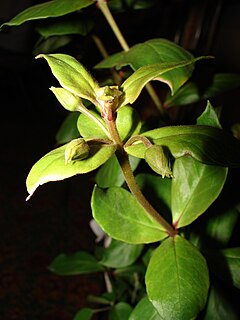
Lysimachia maxima is a rare species of flowering plant in the family Primulaceae known by the common name Pelekunu Trail yellow loosestrife. It is endemic to Hawaii, where there are only two small populations remaining on the island of Molokai. It is federally listed as an endangered species of the United States.
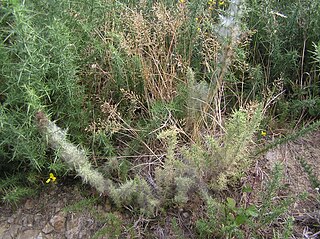
Biological control programs for gorse in New Zealand have existed since the introduction of the gorse seed weevil in 1928. Biological pest control is the use of natural mechanisms such as predation to limit the growth and prevalence of a pest. The early research into the biological control of common gorse in New Zealand was among the first of such programs worldwide.

Elaeocarpus sylvestris, the woodland elaeocarpus, is a tree species in the genus Elaeocarpus.








